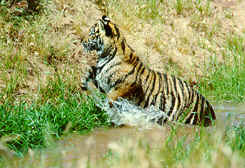|
Aplaceworthsaving.cjb.net https://members.tripod.com/EAPWS/APWS.html ALL OF THE SAME CONTENT AND MORE |
| Tiger
(Panthera Tigris Altaica)
|

|
| The largest
living cat in the world, the Siberian Tiger possesses both grace and
beauty. Although it spends a lot of time hunting, its reputation as a
vicious killer is undeserved.
(Panthera Tigris Altaica) Also known as the Manchurian or Amur Tiger, the Siberian tiger is the largest cat in the world. This tiger is much heavier than the Bengal with two to twenty one inch fur on its back and stomach. In the summer the coat becomes shorter. The Siberian tigers color is lighter than the Bengal with stripes that are brown and narrow. It is native to the cold of Northeast Asia and has been on the endangered list for some time. The Siberian tiger lives primarily in eastern Russia, and a few are found in northeastern China and northern North Korea. It is estimated that 150-200 Siberian tigers still exist in the wild. About 490 captive Siberian tigers are managed in zoos and it is unknown how many exists in the private sector. In this century, the Siberian tiger (sometimes called the Amur, Manchurian, or Northeast China tiger), has survived four wars, two revolutions, and now an onslaught on its forests. Its IUCN status is considered Critical, its numbers in the wild fluctuating from a low of 24 tigers in the 1940s to IUCN estimates of about 150 to 200 in 1994. There are three protected areas for tigers in Russia-the Sikhote-Alin (3,470 km2), Lazovsky (1,165 km2), and Kedrovaya Pad (178 km2) Reserves-inland from the Sea of Japan in the Russian Far East. Sightings of Siberian tigers in Changbaishan, near the Chinese border with North Korea, were reported in Chinese newspapers in 1990, and some are still found along the Russian border. The Cat Specialist Group suggests that there are probably fewer than 50 Siberian tigers in China. Regardless of their authenticity, it is the tigers in Russia that will define the future of the subspecies. The other sites are too small to harbor tiger populations large enough for long-term viability. The survival of wild Siberian tigers will be linked to securing and enlarging their current habitat and protecting them from poachers. The Law of the Russian Federation on Environmental Protection and Management of 1992 gave the Siberian tiger legal protection. Despite this, poaching has received considerable attention in the press, but the reports are rife with rumors. Authorities admit that the killing of tigers is a new enterprise, in part arising from on an unstable and worsening economic situation for most people, open borders to China and Korea, and a demand for tiger body parts for traditional Chinese medicine. Many agencies and organizations are promoting efforts to assist Russia in stopping the poaching on tigers and their prey, the marketing of their skins and bones, and the loss of available habitat. |
|